Crash Cart
- A crash cart or code cart is a set of trays/drawers /shelves on wheels used in hospitals for transportation and dispensing of emergency medication/equipment at the side of medical/surgical emergency for life support protocols to potentially save someones life.
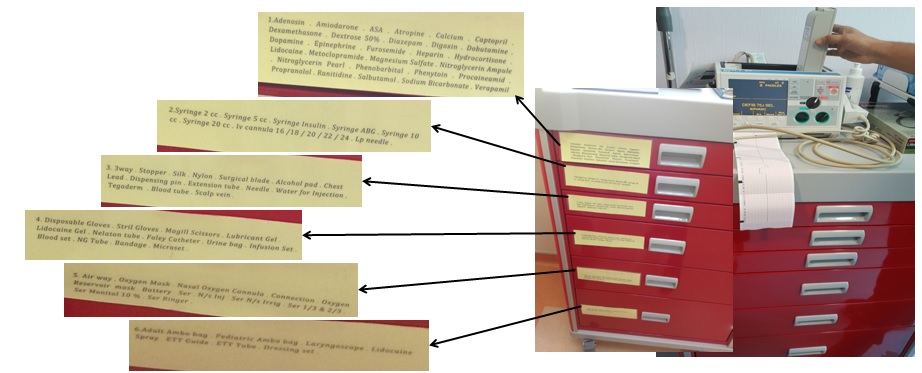
- The size, shape, and contents of a crash cart may be different between hospitals and different departments within the same place.
- For example, an adult crash cart is set up differently than a pediatric crash cart or crash cart on the medical service may be different than the one on a surgical service.
The four common parts of each crash cart:
- Defibrillator
- Breathing equipment/ air supplies(Intubation)
- Emergency drugs(Medications)
- IV supplies and tubing
- Procedure Trays
External Defibrillator
Why a External Defibrillator needs?
- Sudden cardiac arrest usually happens without a warning , and the majority of people have not previously recognized symptoms of the heart disease. Patient survival depends on a rapid sequence of rescue events that may include the successful delivery of a high-energy shock from an external defibrillator.
- This depolarizes a critical mass of the heart muscle, terminates the arrhythmia and allows normal sinus rhythm to be re-established by the sinoatrial node.
- Ventricular Fibrillation is the most common electrical mechanism in cardiac arrest.
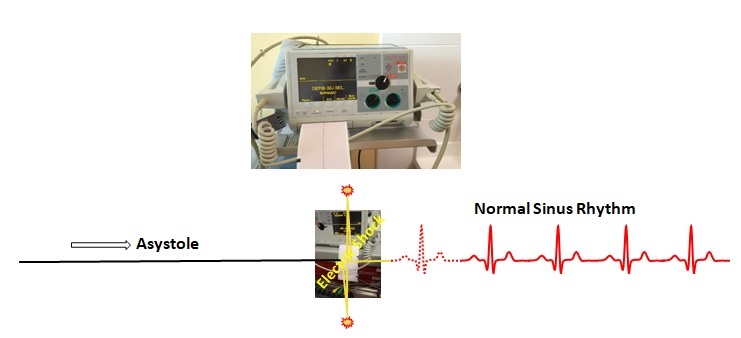
External Defibrillator
- Defibrillators are devices that are designed to deliver electrical energy to the heart for the purposes of stopping a life-threating cardiac arrhythmia and restoring the hearts normal rhythm.
- The term external defibrillator is generally used to refer to any device that operates outside the body and delivers energy through paddles or electrode pads for the purposes of restoring normal rhythm.
- A capacitor is charged with an appropriate level of voltage for the device (either by an operator (press of a button) or automatically) and upon initiation of the shock, current is delivered directly to the heart to interrupt the arrhythmia and restore the normal conduction.
Type of External defibrillator
- Manual External Defibrillator (These units are primarily found in hospitals)
- Wearable Defibrillator
- Automated External Defibrillator
- Semi-automated External Defibrillator
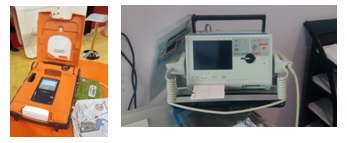
Understanding Defibrillation Waveforms
Let’s define a few terms:
Energy: A joule (J) is the unit of work associated with one amp of current passed through one ohm of resistance for one second.
When we express it in a formula, it is generally stated as follows: Joules (Energy) = Voltage X Current X Time Joules have become a surrogate for current in modern defibrillator language.
Current: Current is what actually defibrillates the heart. It is also expressed as Voltage/Impedance (resistance).
Impedance: Resistance to Flow; there is resistance in the electrical circuit itself as well as in the patient. The amount of impedance in a patient is difficult to determine as it relates to body mass, temperature, diaphoresis quality of the contact with paddles or pads. Impedance is expressed in ohms.
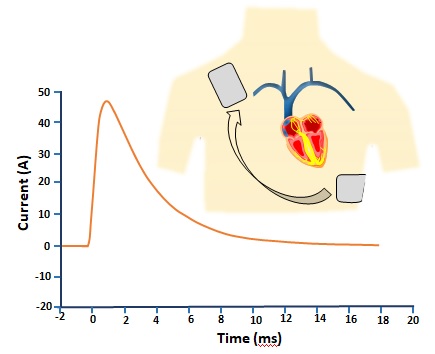
Biphasic Waveforms:
- A shock is delivered to the heart via two vectors.
- Biphasic waveforms were initially developed for use in implantable defibrillators and have since become the standard in external defibrillators.
- All biphasic waveforms have been shown to allow termination of VF at lower current than monophasic defibrillators.
- There are two types of waveforms used in external defibrillators:

Manual external defibrillator
- Require the expertise of a healthcare professional.
- They are used in conjunction with an electrocardiogram, which can be separate or built-in.
- A healthcare provider first diagnoses the cardiac rhythm and then manually determines the voltage and timing for the electrical shock.
- These units are predominantly in hospitals and on some ambulances.
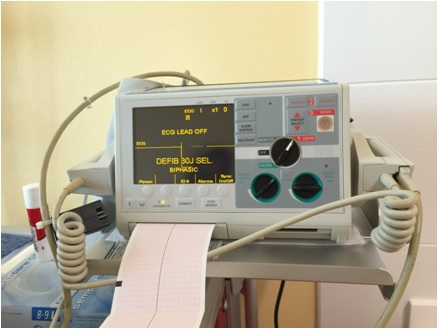
- Sync mode uses a defibrillator discharge to correct certain arrhythmias, such as VT; a shock is delivered only when the control circuits sense the next R wave.
- The delivery of energy is synchronized with and shortly follows the peak of the R wave, preventing discharge during the vulnerable period of ventricular repolarization, which is represented by the T wave.
- An audible/visible indicator informs when the capacitor is charged and the device is ready.
- ECG monitoring can be performed before, during, and after a discharge, usually through ECG electrodes, although most external paddles and disposable electrodes have ECG monitoring capability.
- Many defibrillators are equipped with optional monitoring capabilities (SpO2, ETCO2, Temperature, NIBP).
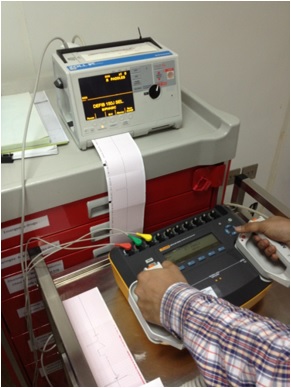
Physics behind Defibrillator
3 major components of a defibrillator:
- Power supply
- Capacitor
- Inductor
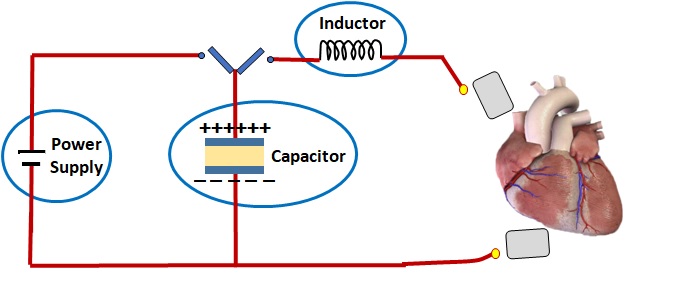
Block Diagram of defibrillator
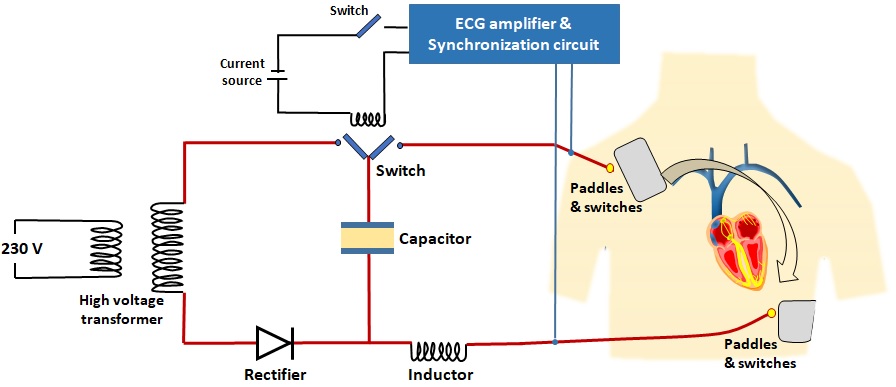
Medications
Medications are usually kept in the top drawer of most crash carts.
These need to be accessed and delivered as quickly as possible in emergent situations (be available to providers very easily).
The common set of first drawer medications might be:
- Alcohol swabs
- Amiodarone
- Atropine
- Sodium bicarbonate Calcium chloride
- Sodium chloride
- Dextrose
- Dopamine
- Epinephrine
- Sterile water
- Lidocaine
- Povidone-Iodine swabstick
- Vasopressin
- Syringes
Intubation
Many crash carts will also include most of the materials necessary to perform in intubation.
These may be contained in the third or fourth drawers depending on the setup of the particular crash cart.
The adult intubation drawer will contain:
- Endotracheal tubes of various sizes
- Nasopharyngeal and perhaps oropharyngeal airways
- Laryngoscope handle and blades of different sizes
- A flashlight
- Bite block
- Tongue depressors
- Adult ambu bag
- Oxygen mask
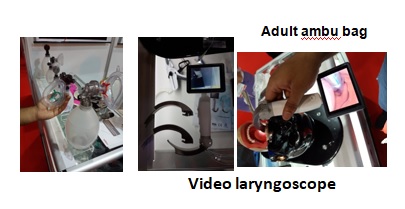
Intravenous lines
It is usually the case that the equipment necessarily to start an IV is in a separate drawer from materials needed to maintain an IV; such as, the fluids in the tubing.
The IV drawer(s) usually contain the following:
- IV Start Kit
- Angiocatheters
- Disinfectants (Chloraprep, Betadine, povidone-iodine)
- Luer lock syringes of various sizes
- Tourniquet tubing
- Insyte autoguards of various sizes
- Vacutainers
- needles of various sizes
- Regular and Spinal needles of various sizes
- 3-Way stopcock
- Tape
- Armboards
- ABG syringes and sampling kits
- Catheter tips
- Tubing
Procedure Trays
The bottom drawer on crash carts is usually devoted to keep prepackaged kits available for various emergent procedures (or it is where the IV solutions are kept).
The following kits may be found in the procedure drawer:
- ECG electrodes
- Sterile gloves of various sizes
- Sutures of various sizes and materials
- Suction supplies
- Salem pump
- Cricothyroidotomy kit
- Adult and pediatric cut down pack
- Drapes to create a sterile field
- Large bore needle and syringe (for tension pneumothorax)
- Suction Cath Kit 14 Fr & 18 Fr
- Lumbar puncture kit